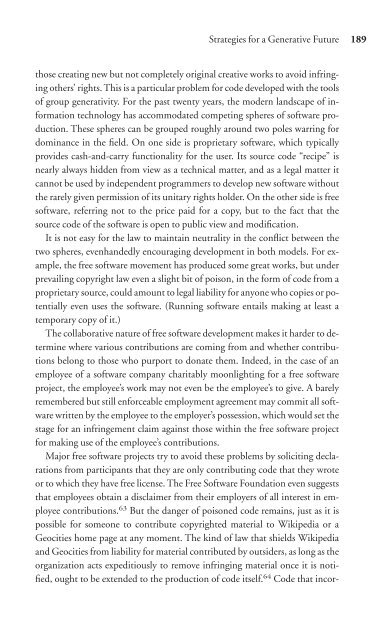Download - Future of the Internet â And how to stop it.
Download - Future of the Internet â And how to stop it.
Download - Future of the Internet â And how to stop it.
You also want an ePaper? Increase the reach of your titles
YUMPU automatically turns print PDFs into web optimized ePapers that Google loves.
Strategies for a Generative <strong>Future</strong> 189<br />
those creating new but not completely original creative works <strong>to</strong> avoid infringing<br />
o<strong>the</strong>rs’ rights. This is a particular problem for code developed w<strong>it</strong>h <strong>the</strong> <strong>to</strong>ols<br />
<strong>of</strong> group generativ<strong>it</strong>y. For <strong>the</strong> past twenty years, <strong>the</strong> modern landscape <strong>of</strong> information<br />
technology has accommodated competing spheres <strong>of</strong> s<strong>of</strong>tware production.<br />
These spheres can be grouped roughly around two poles warring for<br />
dominance in <strong>the</strong> field. On one side is proprietary s<strong>of</strong>tware, which typically<br />
provides cash-and-carry functional<strong>it</strong>y for <strong>the</strong> user. Its source code “recipe” is<br />
nearly always hidden from view as a technical matter, and as a legal matter <strong>it</strong><br />
cannot be used by independent programmers <strong>to</strong> develop new s<strong>of</strong>tware w<strong>it</strong>hout<br />
<strong>the</strong> rarely given permission <strong>of</strong> <strong>it</strong>s un<strong>it</strong>ary rights holder. On <strong>the</strong> o<strong>the</strong>r side is free<br />
s<strong>of</strong>tware, referring not <strong>to</strong> <strong>the</strong> price paid for a copy, but <strong>to</strong> <strong>the</strong> fact that <strong>the</strong><br />
source code <strong>of</strong> <strong>the</strong> s<strong>of</strong>tware is open <strong>to</strong> public view and modification.<br />
It is not easy for <strong>the</strong> law <strong>to</strong> maintain neutral<strong>it</strong>y in <strong>the</strong> conflict between <strong>the</strong><br />
two spheres, evenhandedly encouraging development in both models. For example,<br />
<strong>the</strong> free s<strong>of</strong>tware movement has produced some great works, but under<br />
prevailing copyright law even a slight b<strong>it</strong> <strong>of</strong> poison, in <strong>the</strong> form <strong>of</strong> code from a<br />
proprietary source, could amount <strong>to</strong> legal liabil<strong>it</strong>y for anyone who copies or potentially<br />
even uses <strong>the</strong> s<strong>of</strong>tware. (Running s<strong>of</strong>tware entails making at least a<br />
temporary copy <strong>of</strong> <strong>it</strong>.)<br />
The collaborative nature <strong>of</strong> free s<strong>of</strong>tware development makes <strong>it</strong> harder <strong>to</strong> determine<br />
where various contributions are coming from and whe<strong>the</strong>r contributions<br />
belong <strong>to</strong> those who purport <strong>to</strong> donate <strong>the</strong>m. Indeed, in <strong>the</strong> case <strong>of</strong> an<br />
employee <strong>of</strong> a s<strong>of</strong>tware company char<strong>it</strong>ably moonlighting for a free s<strong>of</strong>tware<br />
project, <strong>the</strong> employee’s work may not even be <strong>the</strong> employee’s <strong>to</strong> give. A barely<br />
remembered but still enforceable employment agreement may comm<strong>it</strong> all s<strong>of</strong>tware<br />
wr<strong>it</strong>ten by <strong>the</strong> employee <strong>to</strong> <strong>the</strong> employer’s possession, which would set <strong>the</strong><br />
stage for an infringement claim against those w<strong>it</strong>hin <strong>the</strong> free s<strong>of</strong>tware project<br />
for making use <strong>of</strong> <strong>the</strong> employee’s contributions.<br />
Major free s<strong>of</strong>tware projects try <strong>to</strong> avoid <strong>the</strong>se problems by solic<strong>it</strong>ing declarations<br />
from participants that <strong>the</strong>y are only contributing code that <strong>the</strong>y wrote<br />
or <strong>to</strong> which <strong>the</strong>y have free license. The Free S<strong>of</strong>tware Foundation even suggests<br />
that employees obtain a disclaimer from <strong>the</strong>ir employers <strong>of</strong> all interest in employee<br />
contributions. 63 But <strong>the</strong> danger <strong>of</strong> poisoned code remains, just as <strong>it</strong> is<br />
possible for someone <strong>to</strong> contribute copyrighted material <strong>to</strong> Wikipedia or a<br />
Geoc<strong>it</strong>ies home page at any moment. The kind <strong>of</strong> law that shields Wikipedia<br />
and Geoc<strong>it</strong>ies from liabil<strong>it</strong>y for material contributed by outsiders, as long as <strong>the</strong><br />
organization acts exped<strong>it</strong>iously <strong>to</strong> remove infringing material once <strong>it</strong> is notified,<br />
ought <strong>to</strong> be extended <strong>to</strong> <strong>the</strong> production <strong>of</strong> code <strong>it</strong>self. 64 Code that incor-


